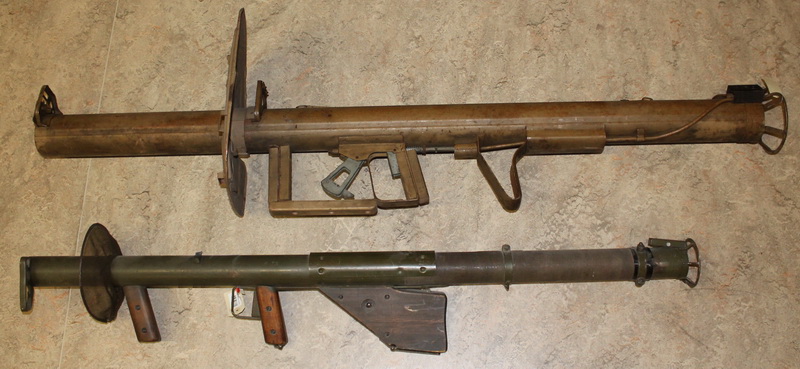
The
8,8cm
R PzB 54 with its small mother, the US M1 Rocket
Launcher
Ein Kriegskind
"A child of war". The history of the Panzerschreck is fascinating since
it was developed as an entirely new weapon system and fielded in less
than 6 months. The following text was printed in the "Von der Front für die Front" issued on 6 June
1944 by the Oberkommando
des Heeres (translated
by myself...).
Important
notes about the Panzerschreck (Ofenrohr)
The
following has been reported by the Heereswaffenamt: With the
fielding of the R Pz B 54 (also
called Ofenrohr) a huge
amount of suggestions for improvements of the weapon has been received
from the units. The Panzerschreck is a "child of war". The development
of the weapon had to be done very fast, in order to give the units a
simple but good weapon to fight against tanks as fast as possible. To
avoid a delay in the distribution of the weapon certain shortcomings is
the price to pay. The need for a gasmask in order to protect the firer
from the rearward flying powder particles during the firing is just one
example.
Development and history
By 1943 the pre-war anti-tank rifles had all gone out of fashion as
their combat value was all gone. The same was happening to the towed
Anti-Tank guns, which were heavy, cumbersome and slow to move,
expensive and just not very efficient at all. They all fired a standard
Armour Piercing (AP) round that depended on the mass-energy (weight of
projectile combined with velocity) to break through armour. Development
of the tanks showing up on the battlefield in 1943 had taken this into
consideration, and thicker armour combined with sloping sides made it a
tough job to kill a tank with an AT gun or a PAK (Panzer Abwehr Kanone).
The shaped-charge principle was well known at the time, and the Germans
used it for demolition charges and magnetic anti-tank charges. It was
not possible to use in a grenade delivered from a rifled barrel though,
as the spin of the grenade needed to stabilize it in its flight would
remove the effect of the shaped-charge when it impacted. In late
1942/early 1943 German engineers developed a new AT weapon that would
use the shaped-charge principle in a High Explosive Anti-Tank (HEAT)
fin-stabilized grenade propelled by a rocket motor. The system
developed was called the Raketenwerfer
43, "Puppchen". It fired
a HEAT grenade from a closed breech and was mounted on
a carriage that could help absorb the recoil

29 "Raketenwerfer 43" captured by the Red Army
The
grenade was designated 8,8cm Raketen Panzer
Granat 4312 (8,8cm R Pz Gr 4312) and was fired using a percussion cap
to ignite
the rocket motor. During flight it was stabilized by fins contained
within a
drum on the tail section.
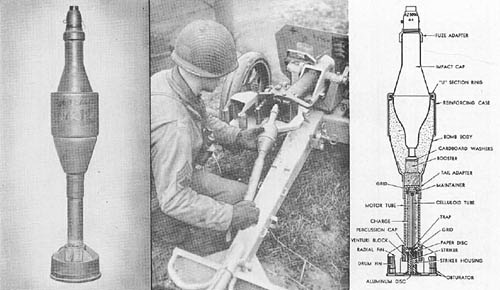
The flange at the rear end is
in fact a very
short casing that contained the primer and would ensure that
the gases didn't escape to the rear but all contributed to the
propulsion of the grenade.
It
was a common misconception that the Puppchen
fired the same grenades as the Raketen
Panzer Büchse 54 that
was developed at the same time. A switch between the two weapons would
be entirely impossible as they used different ignition systems and had
a different tailfin. The misconception is mostly due to the fact that
captured examples of the Raketenwerfer
43 seldom had any ammunition, while the similar looking Raketen Panzer Büchse 54 ammunition seems to
have been readily available. Note that the US
soldier above is holding the longer RPzBGr
4322 for the Raketen
Panzer Büchse 54.
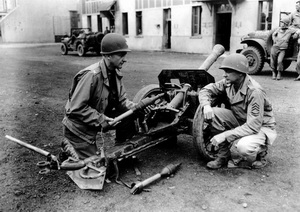 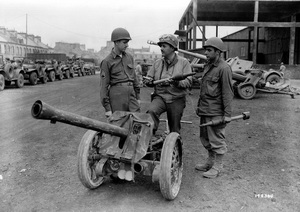
US "Garritroopers" inspect
captured Puppchens. Note the presence of the wrong ammunition in both
pictures!
When
German and US forces
clashed together in Tunisia
in early 1943 the Germans captured some of the newly invented US M1
Rocket Launchers (later nicknamed "Bazooka") with ammunition.
These were promptly sent back to Germany
for further studies. During a demonstration of the newly developed Faustpatrone (Panzerfaust) for the Heereswaffenamt in Kummersdorf in March
1943 one of the captured
US
M1 Rocket
Launchers was demonstrated, and it was decided to develop a German
copy.
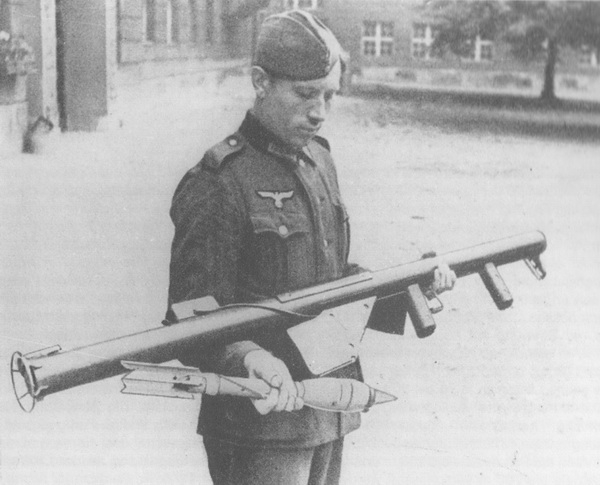
US M1 Rocket
Launcher with ammunition captured in Tunis and presented by the
Heereswaffenamt at Kummersdorf
The
obvious advantages over the already developed Puppchen
were clear. A shoulder held tube could do the same job at 1/10 of the
weight and a fraction of the manufacturing cost, labour hours and raw
materials. The Puppchen
had been under development since the autumn of 1942 and
was ready
for frontline service in September 1943. Orders for mass production had
already been placed, and a number of 3150 examples were
manufactured from September 1943 to February 1944. Further orders were
cancelled in favour of the new anti-tank weapon based on the US
design.
The
German engineers made three important changes to the US M1 rocket
Launcher. First of all the calibre was increased to 8,8cm. As the 8,8cm
R Pz Gr 4312 for the Puppchen was already developed
and had proved itself as reliable during testing they only had to
redesign the ignition system and tail to have functioning ammunition.
Secondly a drum was added to the fins to increase stability and ease
the handling of the grenade. And finally they changed the firing
system. The firing system for the M1 depended on a
electric battery. This system was deemed inadequate by the Germans and
replaced with a simple spring activated rod that hit a shock-generator (Stoßgenerator) and produced the
current necessary to ignite the motor. But even as late as 21.
September 1943 it was reported that trials with a battery for cold
conditions had been halted, so they must have toyed with the idea of
using a battery as well.
The
only disadvantage compared with the Puppchen
was that the closed tube of the Puppchen
could give the rocket a muzzle velocity of 230m/s, while the
open tube of the new weapon only managed 110 m/s. The effective range
would sink from 230m with the Puppchen
to 150m with the new rocket launcher.
Due
to several problems the first batch of "Ofenrohr" was delayed.
The
Heereswaffenamt Wa Prüf 11 was able to deliver the first
production run of 1500 weapons and 5000 grenades for
air transport to the front on the 5'th of October 1943. Another 10000
grenades were ready 10 days later, but the complete run of 15000
grenades was restricted to a more narrow temperature range than later
serial production grenades, and was meant for educational purposes only.
The document below describes some of the problems the Heereswaffenamt
Wa Prüf 11 was facing with the development. I found it so
important that I have chosen to include both the original
document, a transcribed version and a translated version.
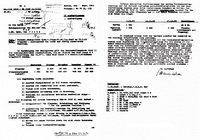 |
 |
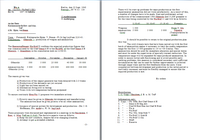 |
| Original
document |
Transcribed
version |
Translated to
English |
The
document also effectively kills two urban myths. First of all that the
name "Ofenrohr" was assigned to the weapon by the troops is clearly
wrong. This document concerns the production of the first batch of
trial weapons, and the weapon is solely referred to as the "Ofenrohr"
by the office responsible for the first production run! The second myth
is the very existence of a "Raketen Panzer Büchse 43". According to
this document the first batch of Ofenrohrs were ready for
delivery on
the 5'th of October 1943, but the first manual with the designation "Raketen
Panzer Büchse 54" was printed on 30 September 1943. So the
very
existence of an "earlier" model is impossible. I will return to this
"problem" later!
A small
comparison
of a early war and a late war AT weapon
| Pak 36 |
Panzerschreck |
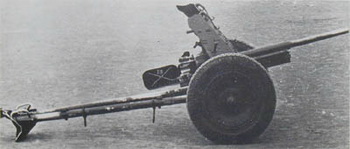 |
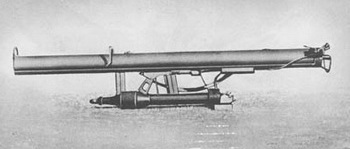 |
| Combat weight
450 kg (952lb) |
Combat weight
9,5 kg (21lb) |
| Would
penetrate 64mm armor at 100m |
Would
penetrate 160mm armor at 100m |
| Production
cost Reichsmark 5730,- |
Production
cost Reichsmark 70,- |
The name says it all
The official designation for the new weapon was "8,8 cm Raketen
Panzer Büchse 54",
with the official abbreviation "8,8 cm R PzB 54".
"Panzer Büchse"
literally translates to "Tank Rifle", but this name is just a
historical left-over from a by then unsatisfactory weapon system.
The first mentioning of this weapon that we have
been able to find is in the "Gerätliste"
(“List of devices”) from 1.7.1943. It lists Neue
Gerät-Nr. 6030 "8,8 cm R Panzerbüchse
6030". The "Gerät"
number is not referred to in any other publications, and was only used
by the developers and industry. The device is also mentioned in a
report from “Der Panzeroffizier im Generalstab
des Heeres” dated
10.08.1943. The report concludes that the “R Pz
B 6030 (Ofenrohr)” will be sent to the frontline
for troop trials very soon. This is also the first recorded
use of the nickname “Ofenrohr”
(“Stove pipe”). A new report one month later, on 8.9.1943, states that
the “Army in the East will soon get a anti-tank weapon with an
effective range of at least 100m with the 8,8-cm-Raketen-Panzerbüchse
43 (Ofenrohr)”.
The first official manual that mentions the weapon is the "Panzer-Beschusstafel 8,8 cm R PzB
54, Stand 30.9. 43". On 29.11.1943 the name “Panzerschreck”
(Tank fear) was officially adopted by Der
Führer. A campaign
to boost morale renamed most of the new weapons issued or under
construction at the time. "Karabin
43"and "Sturmgewehr" are
two other examples. But 8 days later the old name is still printed; on
the 7.12. 1943
came the Merkblatt 77/2 “8,8 cm R PzB 54 (Ofenrohr)
Richtlinien für Ausbildung und Einsatz”. The first official document I have found with
the new nickname is the manual D 1864/1 from 7.6.1944; “Panzerschreck
8,8 cm R PzB 54 mit 8,8 cm R PzBGr 4322, Gebrauchsanleitung”. Why they
choose the model designation "54" is a mystery, but this is in
line with a lot of other newly developed German weapons that got
strange model numbers. To
mention a few; Einstoss-flammenwerfer 46, SS-Gewehr-Panzergranate 61,
8,8-cm-Raketenwerfer 58 and 8,8-cm-Panzerbüchse 70.
A schematic timeline of the names
used at different times
| 01.07.1943 |
8,8 cm R Panzerbüchse 6030 |
| 10.08.1943 |
R Pz B 6030 (Ofenrohr) |
| 08.09.1943 |
8,8-cm-Raketen-Panzerbüchse 43
(Ofenrohr)* |
| 30.09. 1943 |
8,8 cm R PzB 54 |
| 29.11.1943 |
“Panzerschreck” |
| 07.12. 1943 |
8,8 cm R PzB 54 (Ofenrohr) |
| 07.06.1944 |
Panzerschreck 8,8cm R PzB 54 mit
8,8 cm R PzBGr 4322 |
*Not
verified. Based on a report cited in the book "Deutsche Nahkampfmittel".
Despite
the fact that the weapon changed names several times during it’s lifespan of less than 2
years, it was always the same weapon. Improvements were made
continually, but none of these were directly connected with any “model
changes”. The only model-change that was approved and got a new name
was the "8,8 cm R PzB 54/1".
The "Tarnbezeichnung"
(codename) for the weapon that was issued by the "Reichsminister für Rüstung
und Kriegsproduktion"
(Armaments and War Production) was given as
"Erntekranz”
The name was
assigned to the item listed as “8,8
cm Raketen Panzer Büchse 6030”.
It is not known when the codename was first given, but the name is
listed as still in use in a document dated 12.12.1944. This also
indicates that the industry continued to use the Gerätnummer 6030.
Erntekranz
literally means "harvest wreath". The code name was, just like the Gerät number, solely used by the
industry and developers.
The
word "Panzerschreck"
The
German words "Panzer Schrek" literary means Tank Fear. The idea was to
give newly designed weapons aggressive names to boost the morale of the
troops. Incidentally, the first mentioning I have found of the word
"Panzerschreck" was in the Merkblatt
77/2 ...(Ofenrohr) Richtlinien für Ausbildung und Einsatz
from 04.11.1943. In this manual the word is used in conjunction with
own troops' fear for enemy tanks. The manual states that Ofenrohr crews
should be placed in foxholes and run over by friendly tanks in order to
rid them of their "Panzerschreck"! 25 days later the phrase is turned
around and given as the new name for the Ofenrohr!
The illusive Raketen
Panzer Büchse 43
One official “model” that never existed, but is well worth mentioning
was the "8,8 cm Raketen Panzer Büchse 43". As mentioned
earlier, this designation was used in internal reports (not verified)
within the Oberkommando
des Heeres (OKH) for a brief period of less
than a month in 1943, before the official designation was established
as "8,8 cm Raketen Panzer Büchse 54". In most of
my weapon literature books the first model of the Panzerschreck with no
shield is named "Raketen
Panzer Büchse 43". When
I started writing on this article I gathered up information about the
different models (also the "43" that I believed was a separate model at
the time), but it soon struck me that I found no documentation that the
RPzB 43 ever
existed as a designated model. Mass production of the weapon started in
September 1943, with the first 1500 weapons and 5000 grenades delivered
at 5. October 1943 for troop trials. And the first manual from 30.
September states that the name is
“8,8 cm R PzB 54”.
Even the heavily modified and shortened RPzB
54/1 kept the same model number. After a tip that lead me to the “US
Army Intelligence Bulletin November 1944”, it all made sense.
The text in Italic below was borrowed from
Lonesentry.com and is a transcript from the mentioned publication.
Readers also are familiar with such
weapons as the antitank hollow-charge grenade which can be launched
from the
standard rifle, and with the signal pistol fitted to fire hollow
charges.
However, the non-recoil weapons of the bazooka type—a most important
group—have not yet been discussed.
Of this group the first weapon
to be adopted was a frank copy of the bazooka. The
larger German version is called the 8.8-cm Raketenpanzerbüchse 43, or
Ofenrohr (stovepipe) for short.
Sometimes it is called the
Panzerschreck—(tank terror). The Ofenrohr fires an 88-mm hollow-charge
projectile weighing 7 pounds. The maximum range is about 165
yards. The Ofenrohr is clumsier than the bazooka,
and is reputed to
be less accurate.
![[The Ofenrohr with the projectile used in it and in the Püppchen. (Panzerschreck)]](http://www.lonesentry.com/german_antitank/pics/xgerman_antitank16_ofenrohr_bazooka.jpg)
The
Ofenrohr, with the
projectile used in it
and in the Püppchen.
The Püppchen ("Dolly"), a carriage-mounted
rocket launcher with
breechblock also fires the 88-mm rocket. Although the Püppchen has
wheels, the gun can be fired from little sleighs to achieve a very low
silhouette. While the Püppchen, has a range of 770 yards, is
very
lightly built, and is likely to smash up when towed by motor vehicles.
And
the same misconception is written again in the March 1945 issue
There
are two types of German bazooka both of which the German soldiers call Ofenrohr, or "stovepipe." The newer is
the 8.8-cm R.
Pz. B. 54; its
shield for the firer is the feature which principally distinguishes it
from the earlier R.
Pz. B. 43.
According to the Germans, the Ofenrohr's 88-mm, 7.5-pound,
hollow-charge round can achieve penetrations on any Allied armored
vehicle at ranges up to 160 yards, but is not suitable for use against
unarmored targets. Larger and clumsier than the U.S. bazooka, the Ofenrohr has projectile guide tubes,
which wear out after about 300 rounds have been fired.
So this was probably where it all started. The
name "Raketenpanzerbüchse 54" was mixed up with the "Raketenwerfer 43 (Puppchen)". The ammunition was
not interchangeable, as already mentioned. W.H.B.
Smith, the author of "Small arms of the world", most probably based his
information on this. In his 6'th revised edition in March 1945 the
Raketenpanzerbüchse 43 appears for the first time. The text that
accompanies the pictures of the Panzerschreck is written in the form
"It has been reported....".
The text also has an incorrect description of how the firing system
works. It stands to reason that this information at this time was
secondary, collected from US intelligence sources while the war was
still on going. But the name has stuck, so everybody is quoting
everybody else!
The Germans never had a separate model named
"Raketenpanzerbüchse 43", but you will find this model described in
almost all of the post-war weapon literature that includes AT weapons!
Development
of the Raketenpanzerbüchse 54
As mentioned earlier the weapon system fielded
as the Ofenrohr was
flawed with several design faults from the start. But it was considered
crucial to the war effort to supply the troops with better anti-tank
capability, so this was considered a “necessary evil”. Improvements to
the weapon system was a never ending story, from the weapon was sent
out for troop trials until the fall of the Reich. Feedback from the
units equipped with the weapon, as well as new developments by the WA Prüf
11 were implemented both as product improvements on the assembly line,
but also issued as orders to the units to upgrade the existing weapons
in use. Due to this it is impossible to divide the Raketen Panzer Büchse 54 into further models,
although the introduction of the shield is tempting to use as a
distinction between the early and late version.
The Raketen
Panzer Büchse 54 fired
the Raketenpanzerbüchsegranat
4322 (RPzBGr 4322) which
was a shaped-charge grenade (HEAT). The RPzBGr
4322 would penetrate all known tank armour at its time, as long as the
angle of impact didn't get too low. One of the shortcomings of
the RPzBGr 4322
was that it didn't manage to completely burn up the rocket motor before
it left the tube, but would continue to burn for another 2 meters in
its flight. This resulted in burning fragments of propellant that would
hit the gunner, together with secondary debris like sand and gravel.
The gunner had to protect himself by wearing a gas mask (with no
filter) a hood and gloves. This outfit was of course a big nuisance to
the operational use of the weapon. Creeping up on a T34, trying to get
within 75 meters to get a safe kill, with this gear on would be
tiresome at the best.
Other shortcomings included the missing safety bracket used to prevent
the muzzle from scooping up snow and dirt, a stepped rear end that
would make the grenades difficult to load, a grenade catch that had to
be depressed in order to load etc. The sight frames where thin and
fragile, and especially the front sight was prone to bend if the weapon
wasn’t handled
very carefully.
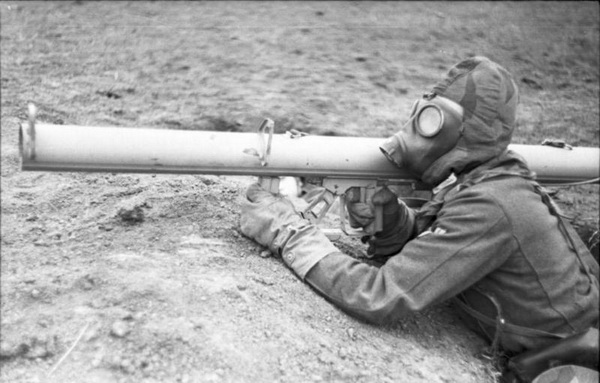
The cumbersome
outfit necessary to fire the Raketenpanzerbüchse 54 early version. The
weapon
above has been cocked and the safety is off.
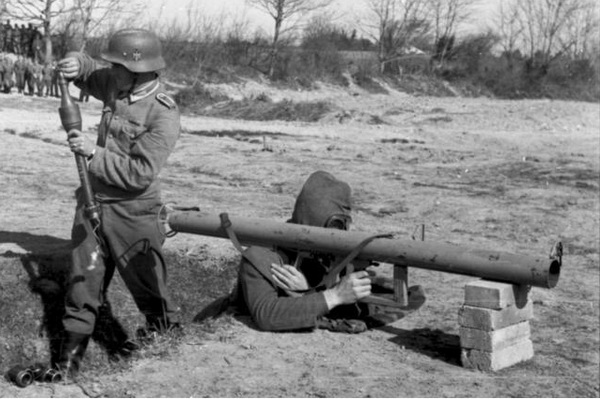
A demonstration in
spring 1944 of the new weapon system. This Panzerschreck has no
modifications.
Due
to the several shortcomings of the weapon system, mainly the problems
with the rocket exhaust, a new improved version soon replaced the early
version at the assembly lines. But at the same time the OKH issued orders to upgrade the
Raketenpanzerbüchse 54 to the same standard as the new weapon, so in
theory the early version would cease to exist. The troops
already equipped with the early version would receive the parts and
instructions to upgrade their weapons to a late version.
For details about this process read the manual D1846/5 which is in fact
a "Upgrading the
Panzerschreck for dummies". The early version was manufactured from
September/October 1943 to approximately January/February 1944.
The late version is basically the same weapon system, but
with some added features that makes it better (but slightly heavier).
The most important improvement was the addition of the protective
shield. This enabled the gunner to skip the gas mask and padded hood,
but he still needed to protect his right hand, as the shield didn't
cover the right side of the weapon.
To prevent dirt and snow from entering the tube in front while the
gunner was manoeuvring into firing position a protective bar (Schutzbügel) was placed under
the muzzle. It could in theory be used as a monopod under ideal
situations, but the trigger guard (Handhabe)
went lower and was more frequently used for this purpose.
The sights were altered with a (sideways) adjustable rear sight notch,
and a single post front sight that was adjustable according to the
ammunition available (summer/winter). The front sight was also made
less transparent in order to protect the glass window from burning
powder particles flying to the rear. The frame was more massive with a
thicker edge and was less prone to be bent. The disadvantage was of
course that spotting and sighting the target became more difficult.
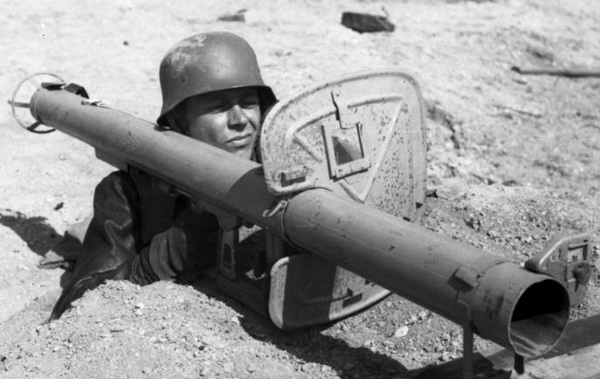
The Panzerschreck above shows the Schutzbügel and the new massive
adjustable sight in place. The gunner is still using gloves,
and the protective bar is used as a monopod. Also note the paint spills
in the tube opening from the factory painting.
The Raketenpanzerbüchse 54 in its second
version with the protective shield appears to have become standard by
mid-1944 with the help of the upgrade kit. The late version was
manufactured from January/February 1944 to August 1944 when production
of the RPzB 54 seems to
have ceased.
The
safety also got an upgrade with a sturdier version that was easier to
operate. Finally the protective ring (Schutzkranz)
was altered to make loading easier.
It is not possible to date some of these “product improvements” as they
don’t appear to
have entered production simultaneously.
The Raketenpanzerbüchse 54/1
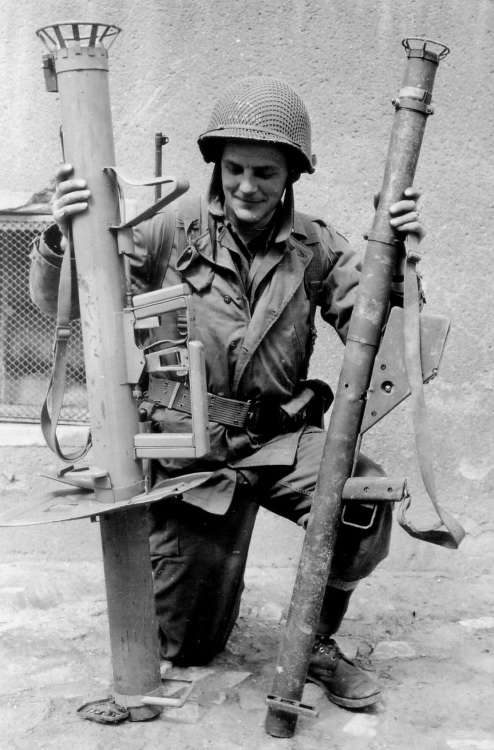
A very rare picture
of the Raketenpanzerbüchse 54/1 that actually saw service. The US
soldier is
comparing it with a M1 Bazooka.
This was the final model of the Panzerschreck.
It was basically a Raketenpanzerbüchse 54 of standard production that
had been shortened and rebuilt with the same improvements that had been
implemented for the 54. None of the 54/1 was manufactured from scratch. With the introduction of the
shield the extremely long tube of the Raketenpanzerbüchse 54 was
pointless. In addition the 54/1 had a new connection system developed
for the new grenade. I have dedicated a whole page to the RPzB 54/1
Comparison of
the different versions and models
The difference
between the Raketenpanzerbüchse 54 early version and the
Raketenpanzerbüchse 54 late version was mainly the added shield and a
few other details. But an "upgrade kit" was issued, so all the
early versions were eventually modified into the late version. Due to
this it is almost impossible to tell if a weapon started as a early or late production
version. The only way to tell them apart is the construction of the
front sight, the new safety and the improved protective ring. The 54/1
was just a shortened 54 and is easily distinguishable from the 54 due
to the shorter barrel. The range and performance depended
entirely on the ammunition in use, and the results would be the same
for all weapons. The grenade developed for the 54/1 could also be used
with the standard Panzerschreck with new sights added.
| Model |
RPzB
54 early version |
RPzB
54 Late version |
RPzB
54/1 |
| Barrel
length |
164 cm |
164 cm |
135 cm |
| Weight |
9,5 kg |
11 kg |
9,5 kg |
None of the other models made it past the
prototype stage so it is impossible to make any comparisons.
On the drawing board
The Raketenpanzerbüchse 54/2
This weapon never made it beyond the prototype stage. No
pictures or drawings are known to exist, but it is described in a
report from the period. It was an even shorter version, measuring only
110cm and weighing only 7.5 kg. It came with an improved support, an
improved shield and a double action trigger that did away with the
cocking lever. It also got an adjustable rear sight for 50 to 250
meters.
The Ersatz
Raketenpanzerbüchse
Between July and December 1944 the German armed forces reportedly lost
12.965 Panzerschrecks. Nearing the end of the war
raw-materials were in constant shortage, so German engineers
tried to save raw materials as best as they could by
redesigning
and improving already existing solutions. One such idea was to
manufacture the Raketenpanzerbüchse from cardboard paper, the so called
"Presstoff". This would save 5,5
kg of metals and reduce the overall weight with 2kg. The
SS-Waffenakademie in Brno was responsible for the prototypes and
testing, but this model never saw serial production.
Other models
A
similar weapon in 10,5 cm codenamed "Hammer" was also developed, but
since this weapon functioned by entirely different principles
(recoilless, but fired like a mortar round with the powder on the
outside of the grenade) it has no resemblance with the Panzerschreck
family and I will not include
it in this article.
|


 Panzerschreck
history and development
Panzerschreck
history and development

![[The Ofenrohr with the projectile used in it and in the Püppchen. (Panzerschreck)]](http://www.lonesentry.com/german_antitank/pics/xgerman_antitank16_ofenrohr_bazooka.jpg)



